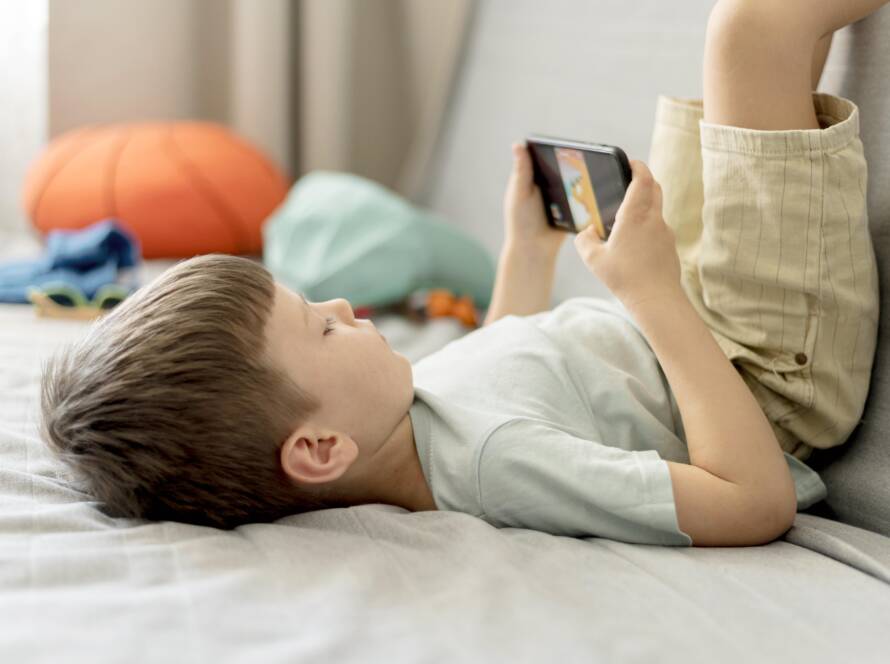Little Aarav’s face lights up every afternoon as his mother props up the tablet on the couch. The screen flickers on, and there she is Grandma, waving excitedly from hundreds of miles away.
“Hi my little munchkin!” she coos, blowing him a big, exaggerated kiss. Aarav starts giggling and smacks his tiny hands against the screen. They play peek-a-boo and make silly faces. Sometimes she even pretends to nibble on his chubby fingers through the screen.
Video chatting is different. It is not like passive screen time, where children simply watch without engaging, Even studies suggest that babies as young as six months can recognize the difference between a live video call and a recorded video.
The smiles, gestures, and laughter exchanged through the screen help build social and communication skills, making video calls one of the few screen activities experts encourage for little ones.
But beyond video chats, what about other forms of screen time? Parenting in a digital world feels overwhelming. One moment screen time seems fine, the next screen time is too much. There is so much conflicting advice, which creates confusion in parent’s minds.
Let’s clear this confusion, and debunk common myths in this blog.
Common Myths About Toddler Screen Time (Debunked!):
Myth 1: Screen time is harmful for toddlers.
Fact:
Not all screen time is bad! What matters is how your child engages with it. Watching high-quality, interactive content especially together can support learning. It’s all about balance and mindful use.
Myth 2: Digital devices can replace traditional learning methods.
Fact:
Think of digital devices as a bonus to learning. Don’t replace them for the real-world magic kids need. Focus more on hands-on experiences. Reading books, outdoor play, and messy, creative exploration should always be given first preference.
Myth 3: All educational apps are beneficial for toddlers.
Fact:
Some apps can be overly stimulating for your toddler, while others lack real value. Parents should look for apps designed with input from child development experts. Try to focus on the apps that encourage problem-solving, creativity, and interaction.
When we separate myths from facts, we can take a balanced approach to screen time. An approach that works for our little ones and for us as parents. No guilt, no fear, just mindful choices that support their growth and well-being.
Best Screen Time Practices for Toddlers
1. Set Screen Time Limits
The American Academy of Pediatrics (AAP) recommends quality of screen time rather than quantity of it for children of all ages.
2. Choose High-Quality Content
Go for age-appropriate, interactive, and educational shows and apps. The right content can turn screen time into a learning opportunity. Parents should pay attention to digital safety for toddlers while choosing the apps.
3. Watch Together
Make screen time a shared experience for your toddler and you. Watch together, and discuss what they see. Ask questions, spark their curiosity, and try to link what they’re watching to real life.
4. Follow the 20-20-20 Rule
Little eyes need a break! Try the 20-20-20 rule. After every 20 minutes, make your child look at something 20 feet away for 20 seconds. You can make it fun by turning it into a game, “Spot the farthest thing you can see!”
5. Balance Screens with Hands-On Play
Make sure screens aren’t replacing playtime. Outdoor adventures, crafts, and reading should be encouraged to keep learning diverse and engaging.
Recommended Safe Apps for Toddlers
Here are some expert-recommended, toddler-friendly apps:
Educational Apps:
- Khan Academy Kids – It is a favourite among parents. Khan Academy is fun and interactive. It is designed by experts.
- PBS Kids Games – Safe, engaging, and full of educational content.
- ABCmouse – It is an award-winning structured learning app. It covers math, reading, phonics and more.
- Endless Alphabet – They help your child playfully build a vocabulary.
- Sago Mini World – They encourage creativity through exploration.
Creative Apps:
- Toca Boca Series– An open-ended play app that sparks the imagination.
- Draw and Tell by Duck Duck Moose –It has fun drawing and storytelling tools.
- LEGO DUPLO World –It combines digital learning with real-world play.
Screen-Free Alternatives for Toddlers
It’s important to mix screen time with plenty of hands-on fun. Let us explore some ideas:
1. The Magic of Outdoor Play
There is pure joy in running barefoot on soft grass. Climbing high on a jungle gym feels thrilling. These little adventures are essential for your child’s growth!
Have you noticed how toddlers are drawn to water? Pouring, splashing, or simply feeling it trickle through their fingers? Let them play with water because it boosts fine motor skills.
Kids build strength, balance, and coordination by jumping over puddles, scrambling up a slide, or running freely. Plus, every little leap and climb teaches them about taking risks and trusting their abilities.
At the heart of it all, play is a child’s way of exploring, learning, and growing.
2. Creative Activities
Sharing below some fun and engaging ways to nurture your child’s creativity:
Finger Painting – Finger painting is an excellent way for children to experiment, learn, and grow through sensory play. It develops sensory skills, fine motor control, and self-expression. The squishy, slippery feel of paint is a fantastic way for toddlers to explore different textures.
Playdough Fun – Playdough strengthens fine motor muscles. It encourages imaginative play in your toddler. Early learning concepts like shapes, colours, and counting become easy to teach.
DIY Crafts –Did you know crafting builds problem-solving skills? The best part? There are no rules, just endless possibilities!
Encourage creativity through hands-on play. It helps children develop confidence, problem-solving skills, and develop a love for learning. So, roll out the paint, grab some glue, and let their imaginations run wild!
3. Sensory Play
Sensory play is a wonderful way for toddlers to explore the world around them. Sensory play helps develop motor skills and engage their senses.
Here are a few sensory-rich experiences your child will love:
Kinetic Sand Play – Kinetic sand is soft, moldable, and oh-so-satisfying to touch. It offers endless possibilities for creative play.
Rice Bin Exploration – A simple bin filled with uncooked rice is a treasure trove of sensory fun! Add scoops, cups, or hidden objects for kids to find. Ask your toddler to pour, and sort. This activity enhances hand-eye coordination.
4. Music and Movement
Music and movement have excellent effects on your toddler’s developing brain. Rhymes boost memory, language development, and listening skills! Adding hand motions or acting out the lyrics makes it even more engaging.
Dancing helps improve balance, motor skills, and confidence. Movement encourages self-expression and keeps little bodies active.
Raising kids in this digital age is all about balance. Screen time doesn’t have to be the enemy—but how it’s used makes all the difference. Parents should use screens wisely. By limiting passive screen exposure and choosing high-quality, interactive content, parents can create a healthy digital environment that nurtures learning, creativity, and emotional well-being. Make informed choices and incorporate a mix of digital and real-world experiences. This way you can create a safe, enriching environment for your toddler.



